Cost Modelling for Sustainable Spoiled Mine Site Rehabilitation
VerifiedAdded on 2023/06/06
|23
|5360
|473
Report
AI Summary
This report provides a background analysis of cost modelling for spoiled mine site rehabilitation in Australia, emphasizing the importance of restoring pre-mining conditions for sustainability. It explores the development of proper landforms, the establishment of sustainable ecosystems, and the evaluation of plant community sustainability. The study addresses the chemical and physical deterioration of environmental resources and promotes the use of post-mining practices for long-term benefits. It outlines problem statements and research questions, reviews prior articles, and demonstrates research methodologies. The report also discusses the project schedule, resources needed, and processes for repairing the environmental effects of mining, aiming to minimize adverse socio-economic effects and maximize socio-economic advantages.
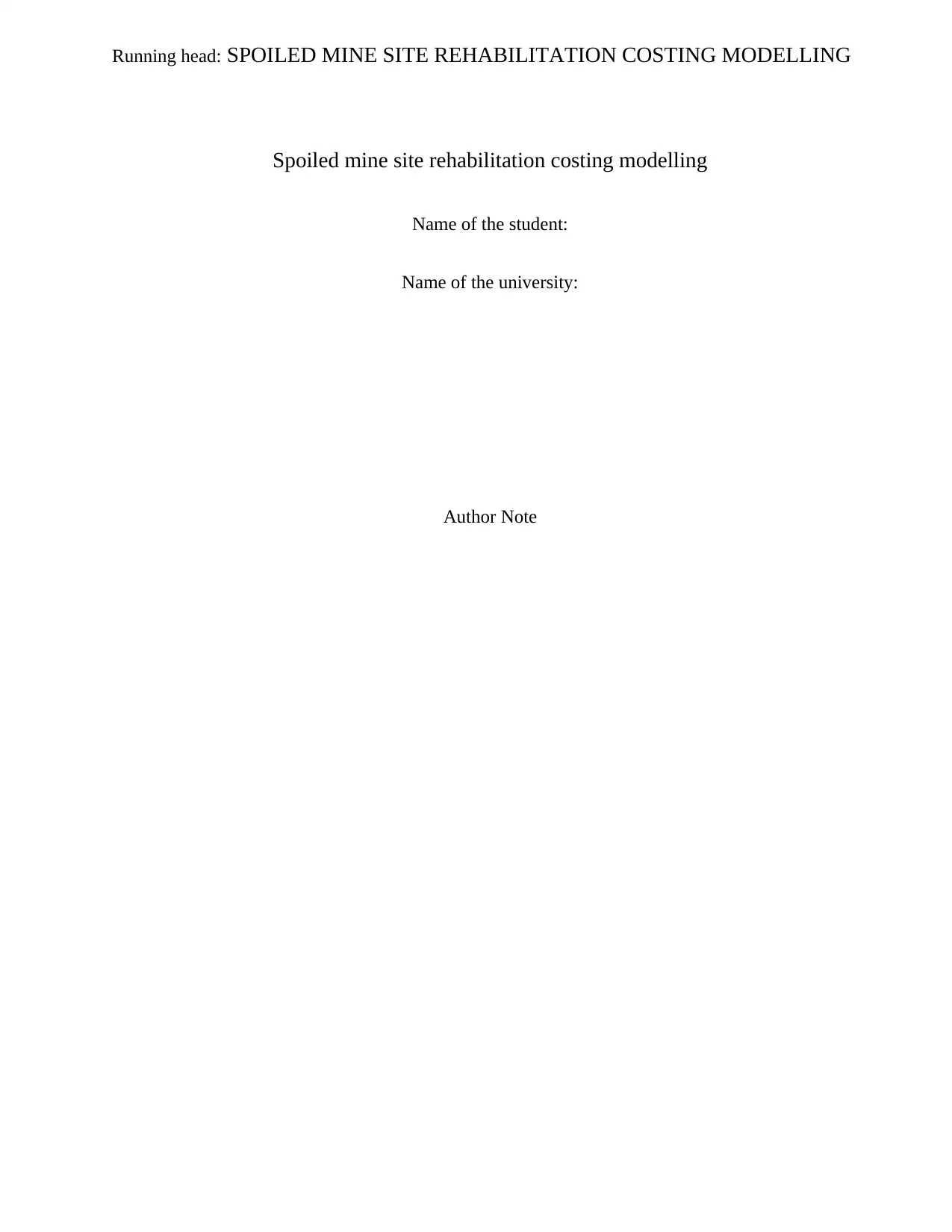
Running head: SPOILED MINE SITE REHABILITATION COSTING MODELLING
Spoiled mine site rehabilitation costing modelling
Name of the student:
Name of the university:
Author Note
Spoiled mine site rehabilitation costing modelling
Name of the student:
Name of the university:
Author Note
Paraphrase This Document
Need a fresh take? Get an instant paraphrase of this document with our AI Paraphraser
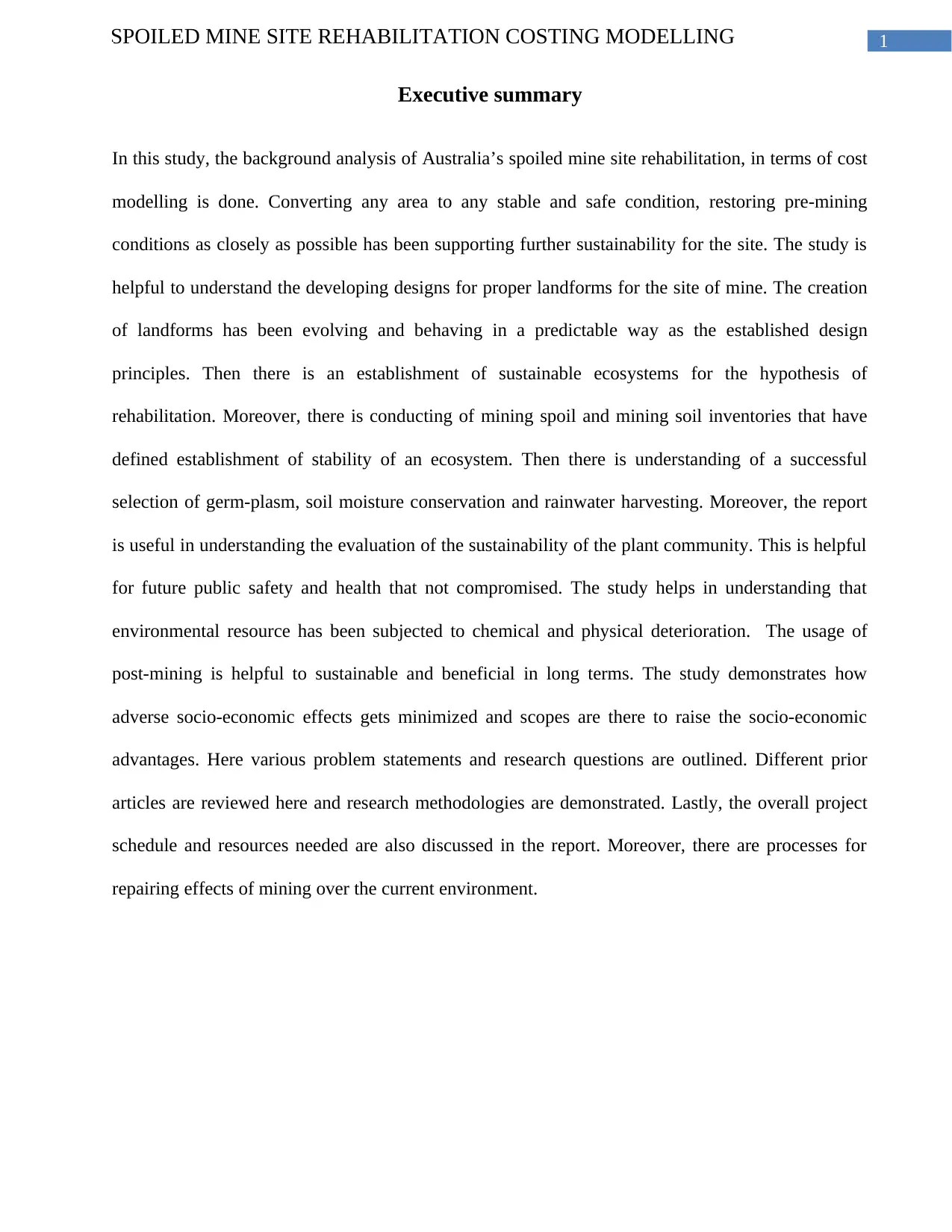
1SPOILED MINE SITE REHABILITATION COSTING MODELLING
Executive summary
In this study, the background analysis of Australia’s spoiled mine site rehabilitation, in terms of cost
modelling is done. Converting any area to any stable and safe condition, restoring pre-mining
conditions as closely as possible has been supporting further sustainability for the site. The study is
helpful to understand the developing designs for proper landforms for the site of mine. The creation
of landforms has been evolving and behaving in a predictable way as the established design
principles. Then there is an establishment of sustainable ecosystems for the hypothesis of
rehabilitation. Moreover, there is conducting of mining spoil and mining soil inventories that have
defined establishment of stability of an ecosystem. Then there is understanding of a successful
selection of germ-plasm, soil moisture conservation and rainwater harvesting. Moreover, the report
is useful in understanding the evaluation of the sustainability of the plant community. This is helpful
for future public safety and health that not compromised. The study helps in understanding that
environmental resource has been subjected to chemical and physical deterioration. The usage of
post-mining is helpful to sustainable and beneficial in long terms. The study demonstrates how
adverse socio-economic effects gets minimized and scopes are there to raise the socio-economic
advantages. Here various problem statements and research questions are outlined. Different prior
articles are reviewed here and research methodologies are demonstrated. Lastly, the overall project
schedule and resources needed are also discussed in the report. Moreover, there are processes for
repairing effects of mining over the current environment.
Executive summary
In this study, the background analysis of Australia’s spoiled mine site rehabilitation, in terms of cost
modelling is done. Converting any area to any stable and safe condition, restoring pre-mining
conditions as closely as possible has been supporting further sustainability for the site. The study is
helpful to understand the developing designs for proper landforms for the site of mine. The creation
of landforms has been evolving and behaving in a predictable way as the established design
principles. Then there is an establishment of sustainable ecosystems for the hypothesis of
rehabilitation. Moreover, there is conducting of mining spoil and mining soil inventories that have
defined establishment of stability of an ecosystem. Then there is understanding of a successful
selection of germ-plasm, soil moisture conservation and rainwater harvesting. Moreover, the report
is useful in understanding the evaluation of the sustainability of the plant community. This is helpful
for future public safety and health that not compromised. The study helps in understanding that
environmental resource has been subjected to chemical and physical deterioration. The usage of
post-mining is helpful to sustainable and beneficial in long terms. The study demonstrates how
adverse socio-economic effects gets minimized and scopes are there to raise the socio-economic
advantages. Here various problem statements and research questions are outlined. Different prior
articles are reviewed here and research methodologies are demonstrated. Lastly, the overall project
schedule and resources needed are also discussed in the report. Moreover, there are processes for
repairing effects of mining over the current environment.
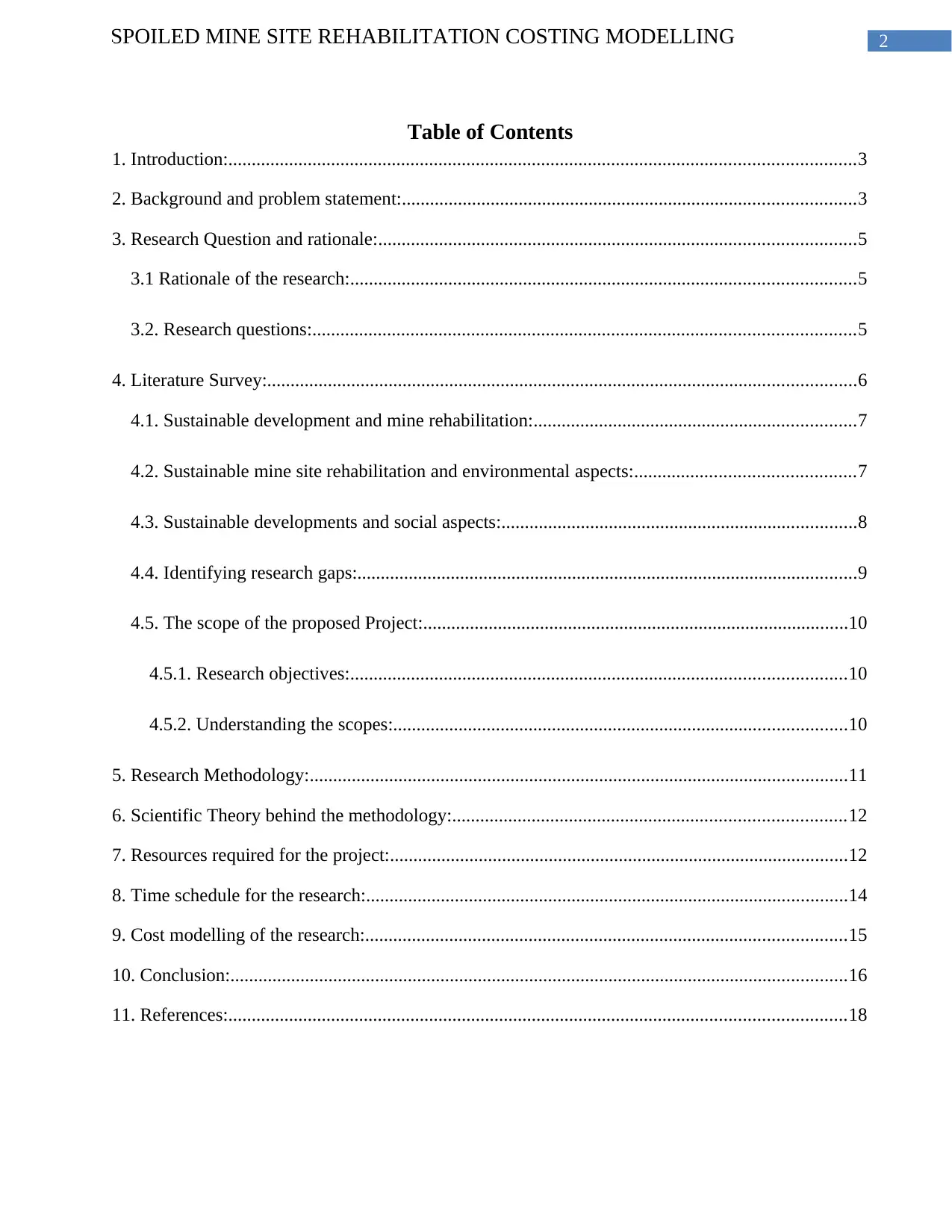
2SPOILED MINE SITE REHABILITATION COSTING MODELLING
Table of Contents
1. Introduction:......................................................................................................................................3
2. Background and problem statement:.................................................................................................3
3. Research Question and rationale:......................................................................................................5
3.1 Rationale of the research:............................................................................................................5
3.2. Research questions:....................................................................................................................5
4. Literature Survey:..............................................................................................................................6
4.1. Sustainable development and mine rehabilitation:.....................................................................7
4.2. Sustainable mine site rehabilitation and environmental aspects:...............................................7
4.3. Sustainable developments and social aspects:............................................................................8
4.4. Identifying research gaps:...........................................................................................................9
4.5. The scope of the proposed Project:...........................................................................................10
4.5.1. Research objectives:..........................................................................................................10
4.5.2. Understanding the scopes:.................................................................................................10
5. Research Methodology:...................................................................................................................11
6. Scientific Theory behind the methodology:....................................................................................12
7. Resources required for the project:..................................................................................................12
8. Time schedule for the research:.......................................................................................................14
9. Cost modelling of the research:.......................................................................................................15
10. Conclusion:....................................................................................................................................16
11. References:....................................................................................................................................18
Table of Contents
1. Introduction:......................................................................................................................................3
2. Background and problem statement:.................................................................................................3
3. Research Question and rationale:......................................................................................................5
3.1 Rationale of the research:............................................................................................................5
3.2. Research questions:....................................................................................................................5
4. Literature Survey:..............................................................................................................................6
4.1. Sustainable development and mine rehabilitation:.....................................................................7
4.2. Sustainable mine site rehabilitation and environmental aspects:...............................................7
4.3. Sustainable developments and social aspects:............................................................................8
4.4. Identifying research gaps:...........................................................................................................9
4.5. The scope of the proposed Project:...........................................................................................10
4.5.1. Research objectives:..........................................................................................................10
4.5.2. Understanding the scopes:.................................................................................................10
5. Research Methodology:...................................................................................................................11
6. Scientific Theory behind the methodology:....................................................................................12
7. Resources required for the project:..................................................................................................12
8. Time schedule for the research:.......................................................................................................14
9. Cost modelling of the research:.......................................................................................................15
10. Conclusion:....................................................................................................................................16
11. References:....................................................................................................................................18
⊘ This is a preview!⊘
Do you want full access?
Subscribe today to unlock all pages.

Trusted by 1+ million students worldwide
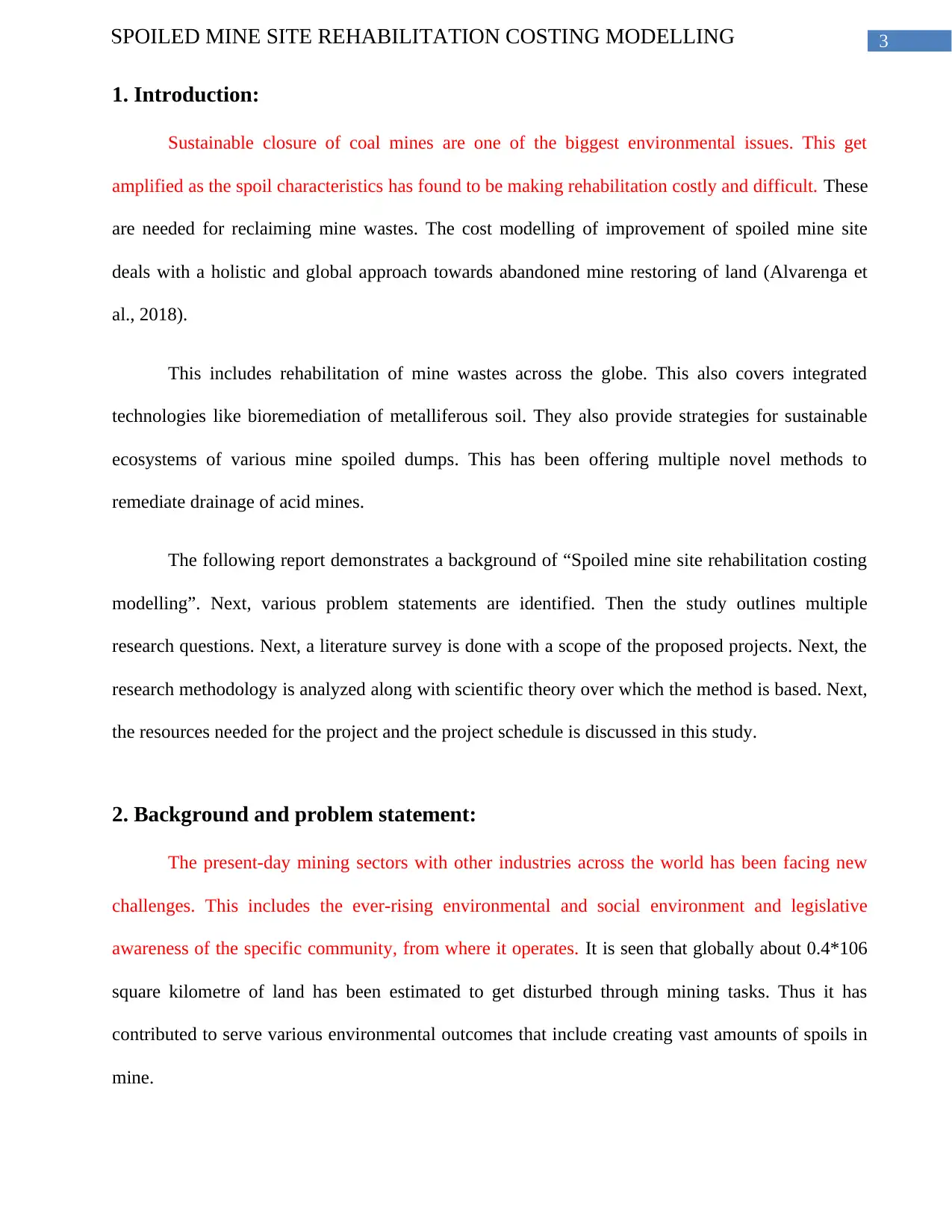
3SPOILED MINE SITE REHABILITATION COSTING MODELLING
1. Introduction:
Sustainable closure of coal mines are one of the biggest environmental issues. This get
amplified as the spoil characteristics has found to be making rehabilitation costly and difficult. These
are needed for reclaiming mine wastes. The cost modelling of improvement of spoiled mine site
deals with a holistic and global approach towards abandoned mine restoring of land (Alvarenga et
al., 2018).
This includes rehabilitation of mine wastes across the globe. This also covers integrated
technologies like bioremediation of metalliferous soil. They also provide strategies for sustainable
ecosystems of various mine spoiled dumps. This has been offering multiple novel methods to
remediate drainage of acid mines.
The following report demonstrates a background of “Spoiled mine site rehabilitation costing
modelling”. Next, various problem statements are identified. Then the study outlines multiple
research questions. Next, a literature survey is done with a scope of the proposed projects. Next, the
research methodology is analyzed along with scientific theory over which the method is based. Next,
the resources needed for the project and the project schedule is discussed in this study.
2. Background and problem statement:
The present-day mining sectors with other industries across the world has been facing new
challenges. This includes the ever-rising environmental and social environment and legislative
awareness of the specific community, from where it operates. It is seen that globally about 0.4*106
square kilometre of land has been estimated to get disturbed through mining tasks. Thus it has
contributed to serve various environmental outcomes that include creating vast amounts of spoils in
mine.
1. Introduction:
Sustainable closure of coal mines are one of the biggest environmental issues. This get
amplified as the spoil characteristics has found to be making rehabilitation costly and difficult. These
are needed for reclaiming mine wastes. The cost modelling of improvement of spoiled mine site
deals with a holistic and global approach towards abandoned mine restoring of land (Alvarenga et
al., 2018).
This includes rehabilitation of mine wastes across the globe. This also covers integrated
technologies like bioremediation of metalliferous soil. They also provide strategies for sustainable
ecosystems of various mine spoiled dumps. This has been offering multiple novel methods to
remediate drainage of acid mines.
The following report demonstrates a background of “Spoiled mine site rehabilitation costing
modelling”. Next, various problem statements are identified. Then the study outlines multiple
research questions. Next, a literature survey is done with a scope of the proposed projects. Next, the
research methodology is analyzed along with scientific theory over which the method is based. Next,
the resources needed for the project and the project schedule is discussed in this study.
2. Background and problem statement:
The present-day mining sectors with other industries across the world has been facing new
challenges. This includes the ever-rising environmental and social environment and legislative
awareness of the specific community, from where it operates. It is seen that globally about 0.4*106
square kilometre of land has been estimated to get disturbed through mining tasks. Thus it has
contributed to serve various environmental outcomes that include creating vast amounts of spoils in
mine.
Paraphrase This Document
Need a fresh take? Get an instant paraphrase of this document with our AI Paraphraser

4SPOILED MINE SITE REHABILITATION COSTING MODELLING
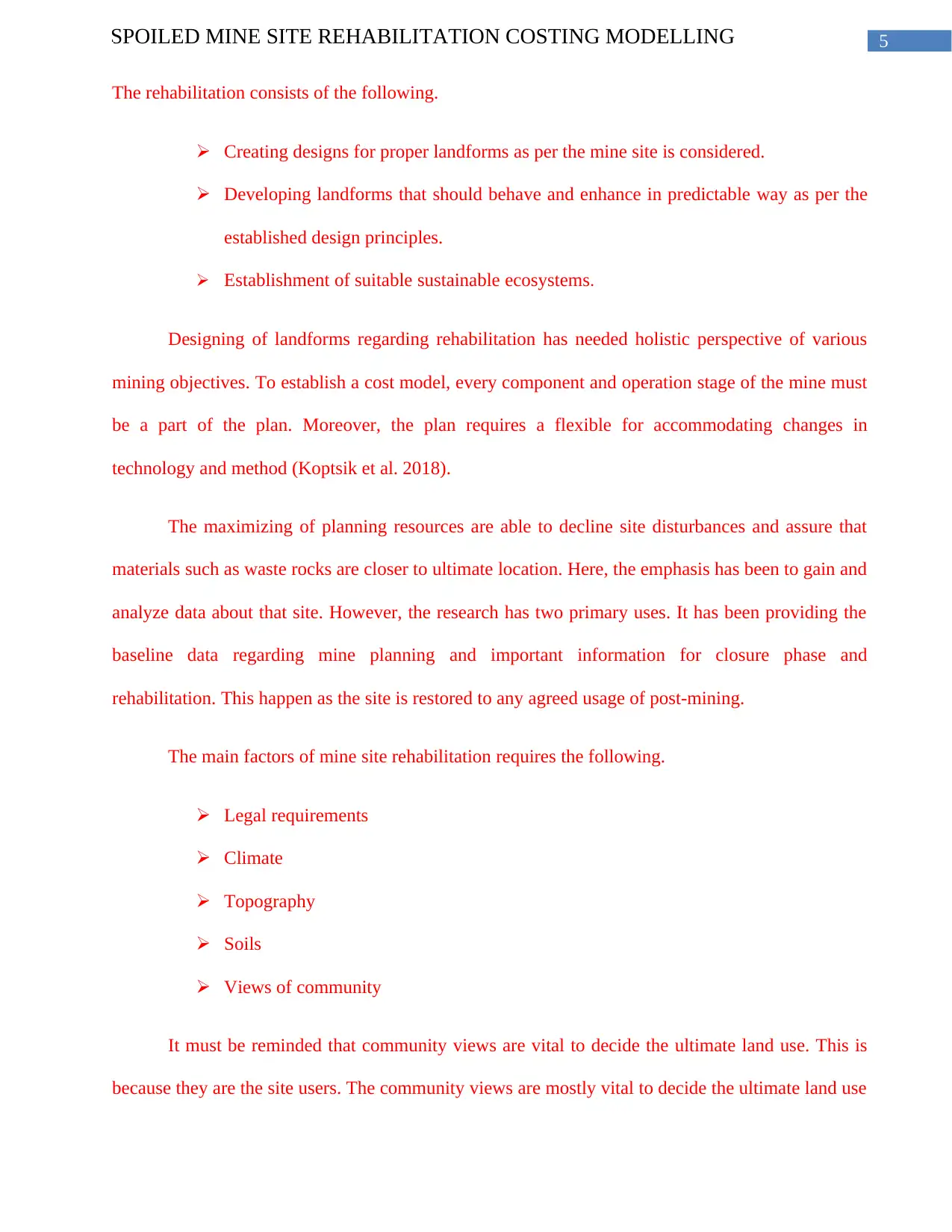
5SPOILED MINE SITE REHABILITATION COSTING MODELLING
The rehabilitation consists of the following.
Creating designs for proper landforms as per the mine site is considered.
Developing landforms that should behave and enhance in predictable way as per the
established design principles.
Establishment of suitable sustainable ecosystems.
Designing of landforms regarding rehabilitation has needed holistic perspective of various
mining objectives. To establish a cost model, every component and operation stage of the mine must
be a part of the plan. Moreover, the plan requires a flexible for accommodating changes in
technology and method (Koptsik et al. 2018).
The maximizing of planning resources are able to decline site disturbances and assure that
materials such as waste rocks are closer to ultimate location. Here, the emphasis has been to gain and
analyze data about that site. However, the research has two primary uses. It has been providing the
baseline data regarding mine planning and important information for closure phase and
rehabilitation. This happen as the site is restored to any agreed usage of post-mining.
The main factors of mine site rehabilitation requires the following.
Legal requirements
Climate
Topography
Soils
Views of community
It must be reminded that community views are vital to decide the ultimate land use. This is
because they are the site users. The community views are mostly vital to decide the ultimate land use
The rehabilitation consists of the following.
Creating designs for proper landforms as per the mine site is considered.
Developing landforms that should behave and enhance in predictable way as per the
established design principles.
Establishment of suitable sustainable ecosystems.
Designing of landforms regarding rehabilitation has needed holistic perspective of various
mining objectives. To establish a cost model, every component and operation stage of the mine must
be a part of the plan. Moreover, the plan requires a flexible for accommodating changes in
technology and method (Koptsik et al. 2018).
The maximizing of planning resources are able to decline site disturbances and assure that
materials such as waste rocks are closer to ultimate location. Here, the emphasis has been to gain and
analyze data about that site. However, the research has two primary uses. It has been providing the
baseline data regarding mine planning and important information for closure phase and
rehabilitation. This happen as the site is restored to any agreed usage of post-mining.
The main factors of mine site rehabilitation requires the following.
Legal requirements
Climate
Topography
Soils
Views of community
It must be reminded that community views are vital to decide the ultimate land use. This is
because they are the site users. The community views are mostly vital to decide the ultimate land use
⊘ This is a preview!⊘
Do you want full access?
Subscribe today to unlock all pages.

Trusted by 1+ million students worldwide
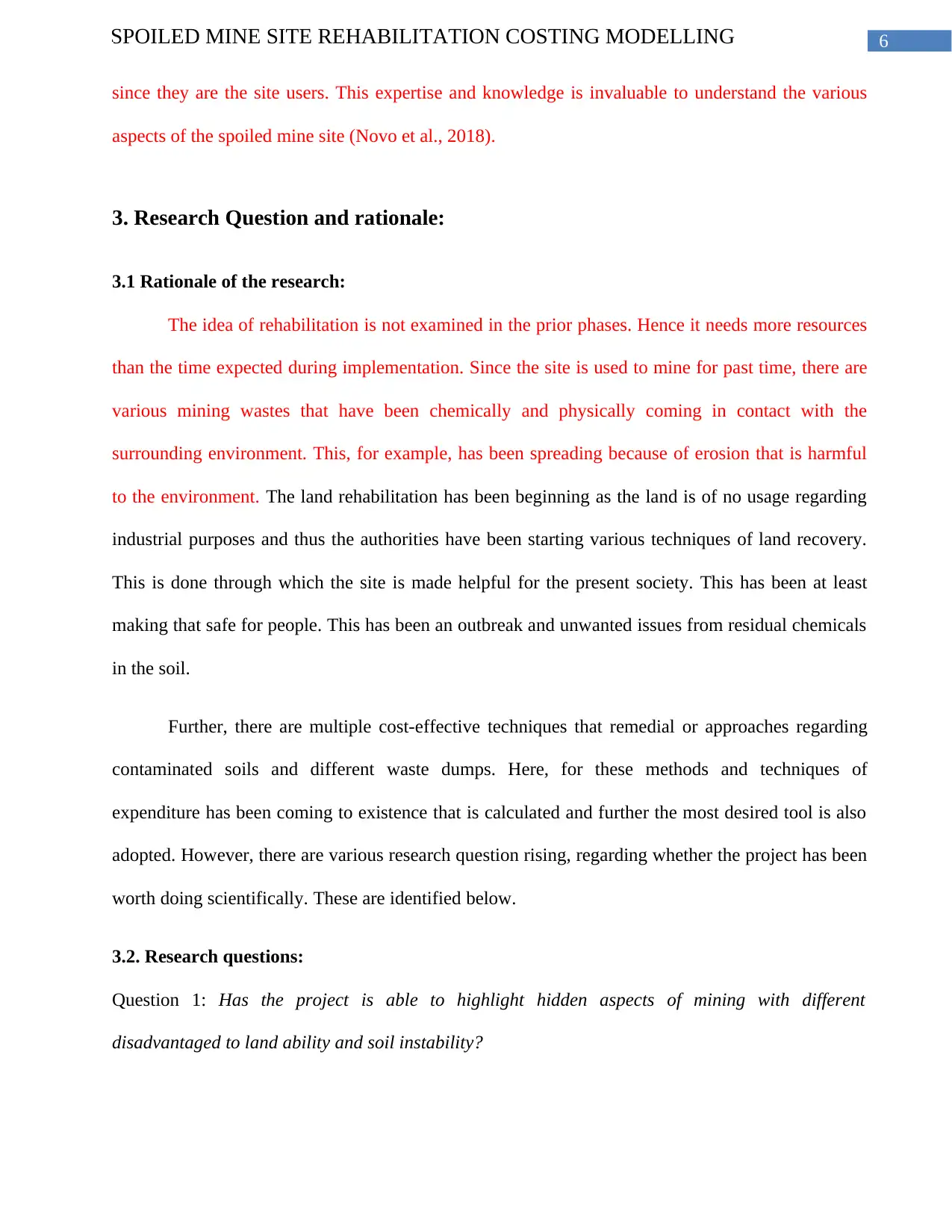
6SPOILED MINE SITE REHABILITATION COSTING MODELLING
since they are the site users. This expertise and knowledge is invaluable to understand the various
aspects of the spoiled mine site (Novo et al., 2018).
3. Research Question and rationale:
3.1 Rationale of the research:
The idea of rehabilitation is not examined in the prior phases. Hence it needs more resources
than the time expected during implementation. Since the site is used to mine for past time, there are
various mining wastes that have been chemically and physically coming in contact with the
surrounding environment. This, for example, has been spreading because of erosion that is harmful
to the environment. The land rehabilitation has been beginning as the land is of no usage regarding
industrial purposes and thus the authorities have been starting various techniques of land recovery.
This is done through which the site is made helpful for the present society. This has been at least
making that safe for people. This has been an outbreak and unwanted issues from residual chemicals
in the soil.
Further, there are multiple cost-effective techniques that remedial or approaches regarding
contaminated soils and different waste dumps. Here, for these methods and techniques of
expenditure has been coming to existence that is calculated and further the most desired tool is also
adopted. However, there are various research question rising, regarding whether the project has been
worth doing scientifically. These are identified below.
3.2. Research questions:
Question 1: Has the project is able to highlight hidden aspects of mining with different
disadvantaged to land ability and soil instability?
since they are the site users. This expertise and knowledge is invaluable to understand the various
aspects of the spoiled mine site (Novo et al., 2018).
3. Research Question and rationale:
3.1 Rationale of the research:
The idea of rehabilitation is not examined in the prior phases. Hence it needs more resources
than the time expected during implementation. Since the site is used to mine for past time, there are
various mining wastes that have been chemically and physically coming in contact with the
surrounding environment. This, for example, has been spreading because of erosion that is harmful
to the environment. The land rehabilitation has been beginning as the land is of no usage regarding
industrial purposes and thus the authorities have been starting various techniques of land recovery.
This is done through which the site is made helpful for the present society. This has been at least
making that safe for people. This has been an outbreak and unwanted issues from residual chemicals
in the soil.
Further, there are multiple cost-effective techniques that remedial or approaches regarding
contaminated soils and different waste dumps. Here, for these methods and techniques of
expenditure has been coming to existence that is calculated and further the most desired tool is also
adopted. However, there are various research question rising, regarding whether the project has been
worth doing scientifically. These are identified below.
3.2. Research questions:
Question 1: Has the project is able to highlight hidden aspects of mining with different
disadvantaged to land ability and soil instability?
Paraphrase This Document
Need a fresh take? Get an instant paraphrase of this document with our AI Paraphraser
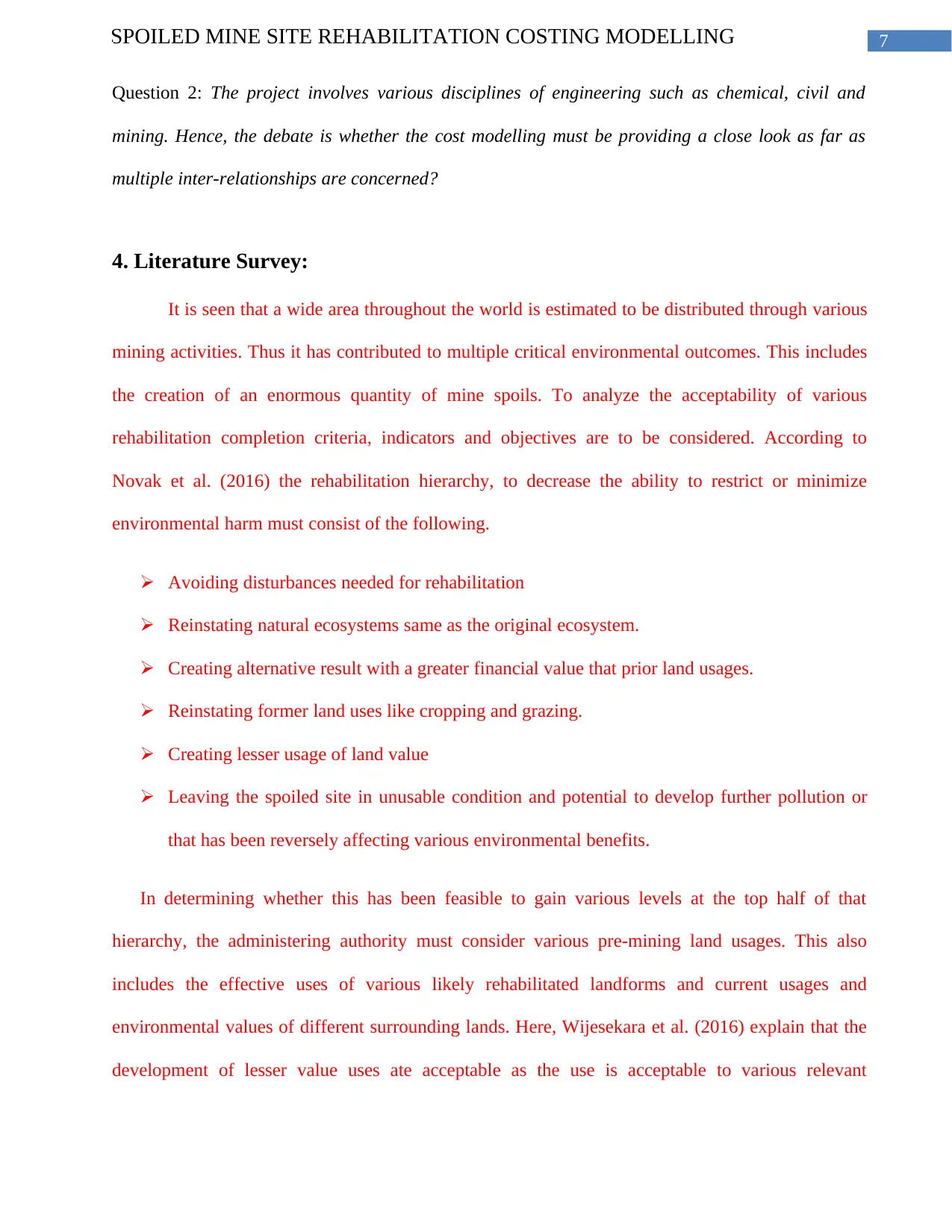
7SPOILED MINE SITE REHABILITATION COSTING MODELLING
Question 2: The project involves various disciplines of engineering such as chemical, civil and
mining. Hence, the debate is whether the cost modelling must be providing a close look as far as
multiple inter-relationships are concerned?
4. Literature Survey:
It is seen that a wide area throughout the world is estimated to be distributed through various
mining activities. Thus it has contributed to multiple critical environmental outcomes. This includes
the creation of an enormous quantity of mine spoils. To analyze the acceptability of various
rehabilitation completion criteria, indicators and objectives are to be considered. According to
Novak et al. (2016) the rehabilitation hierarchy, to decrease the ability to restrict or minimize
environmental harm must consist of the following.
Avoiding disturbances needed for rehabilitation
Reinstating natural ecosystems same as the original ecosystem.
Creating alternative result with a greater financial value that prior land usages.
Reinstating former land uses like cropping and grazing.
Creating lesser usage of land value
Leaving the spoiled site in unusable condition and potential to develop further pollution or
that has been reversely affecting various environmental benefits.
In determining whether this has been feasible to gain various levels at the top half of that
hierarchy, the administering authority must consider various pre-mining land usages. This also
includes the effective uses of various likely rehabilitated landforms and current usages and
environmental values of different surrounding lands. Here, Wijesekara et al. (2016) explain that the
development of lesser value uses ate acceptable as the use is acceptable to various relevant
Question 2: The project involves various disciplines of engineering such as chemical, civil and
mining. Hence, the debate is whether the cost modelling must be providing a close look as far as
multiple inter-relationships are concerned?
4. Literature Survey:
It is seen that a wide area throughout the world is estimated to be distributed through various
mining activities. Thus it has contributed to multiple critical environmental outcomes. This includes
the creation of an enormous quantity of mine spoils. To analyze the acceptability of various
rehabilitation completion criteria, indicators and objectives are to be considered. According to
Novak et al. (2016) the rehabilitation hierarchy, to decrease the ability to restrict or minimize
environmental harm must consist of the following.
Avoiding disturbances needed for rehabilitation
Reinstating natural ecosystems same as the original ecosystem.
Creating alternative result with a greater financial value that prior land usages.
Reinstating former land uses like cropping and grazing.
Creating lesser usage of land value
Leaving the spoiled site in unusable condition and potential to develop further pollution or
that has been reversely affecting various environmental benefits.
In determining whether this has been feasible to gain various levels at the top half of that
hierarchy, the administering authority must consider various pre-mining land usages. This also
includes the effective uses of various likely rehabilitated landforms and current usages and
environmental values of different surrounding lands. Here, Wijesekara et al. (2016) explain that the
development of lesser value uses ate acceptable as the use is acceptable to various relevant
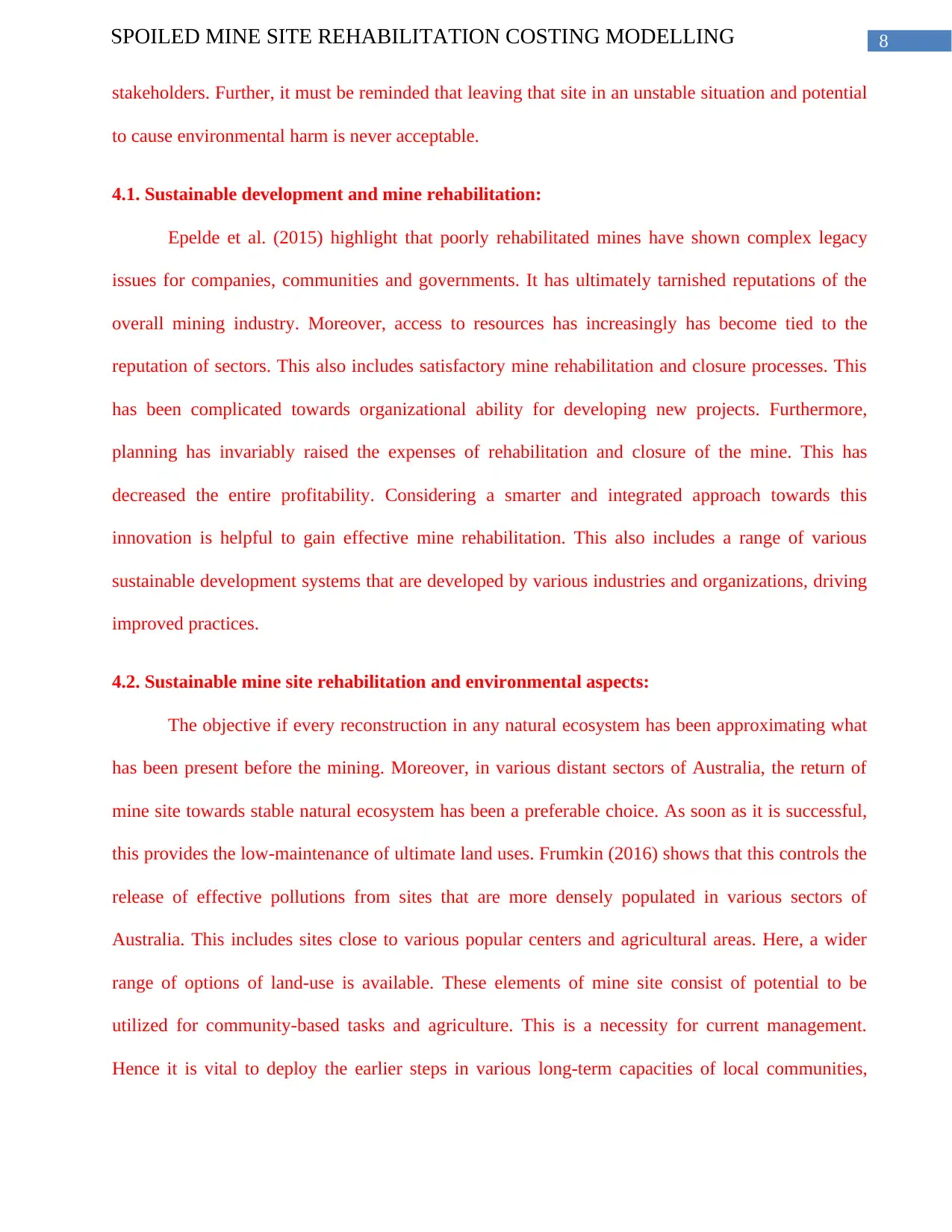
8SPOILED MINE SITE REHABILITATION COSTING MODELLING
stakeholders. Further, it must be reminded that leaving that site in an unstable situation and potential
to cause environmental harm is never acceptable.
4.1. Sustainable development and mine rehabilitation:
Epelde et al. (2015) highlight that poorly rehabilitated mines have shown complex legacy
issues for companies, communities and governments. It has ultimately tarnished reputations of the
overall mining industry. Moreover, access to resources has increasingly has become tied to the
reputation of sectors. This also includes satisfactory mine rehabilitation and closure processes. This
has been complicated towards organizational ability for developing new projects. Furthermore,
planning has invariably raised the expenses of rehabilitation and closure of the mine. This has
decreased the entire profitability. Considering a smarter and integrated approach towards this
innovation is helpful to gain effective mine rehabilitation. This also includes a range of various
sustainable development systems that are developed by various industries and organizations, driving
improved practices.
4.2. Sustainable mine site rehabilitation and environmental aspects:
The objective if every reconstruction in any natural ecosystem has been approximating what
has been present before the mining. Moreover, in various distant sectors of Australia, the return of
mine site towards stable natural ecosystem has been a preferable choice. As soon as it is successful,
this provides the low-maintenance of ultimate land uses. Frumkin (2016) shows that this controls the
release of effective pollutions from sites that are more densely populated in various sectors of
Australia. This includes sites close to various popular centers and agricultural areas. Here, a wider
range of options of land-use is available. These elements of mine site consist of potential to be
utilized for community-based tasks and agriculture. This is a necessity for current management.
Hence it is vital to deploy the earlier steps in various long-term capacities of local communities,
stakeholders. Further, it must be reminded that leaving that site in an unstable situation and potential
to cause environmental harm is never acceptable.
4.1. Sustainable development and mine rehabilitation:
Epelde et al. (2015) highlight that poorly rehabilitated mines have shown complex legacy
issues for companies, communities and governments. It has ultimately tarnished reputations of the
overall mining industry. Moreover, access to resources has increasingly has become tied to the
reputation of sectors. This also includes satisfactory mine rehabilitation and closure processes. This
has been complicated towards organizational ability for developing new projects. Furthermore,
planning has invariably raised the expenses of rehabilitation and closure of the mine. This has
decreased the entire profitability. Considering a smarter and integrated approach towards this
innovation is helpful to gain effective mine rehabilitation. This also includes a range of various
sustainable development systems that are developed by various industries and organizations, driving
improved practices.
4.2. Sustainable mine site rehabilitation and environmental aspects:
The objective if every reconstruction in any natural ecosystem has been approximating what
has been present before the mining. Moreover, in various distant sectors of Australia, the return of
mine site towards stable natural ecosystem has been a preferable choice. As soon as it is successful,
this provides the low-maintenance of ultimate land uses. Frumkin (2016) shows that this controls the
release of effective pollutions from sites that are more densely populated in various sectors of
Australia. This includes sites close to various popular centers and agricultural areas. Here, a wider
range of options of land-use is available. These elements of mine site consist of potential to be
utilized for community-based tasks and agriculture. This is a necessity for current management.
Hence it is vital to deploy the earlier steps in various long-term capacities of local communities,
⊘ This is a preview!⊘
Do you want full access?
Subscribe today to unlock all pages.

Trusted by 1+ million students worldwide
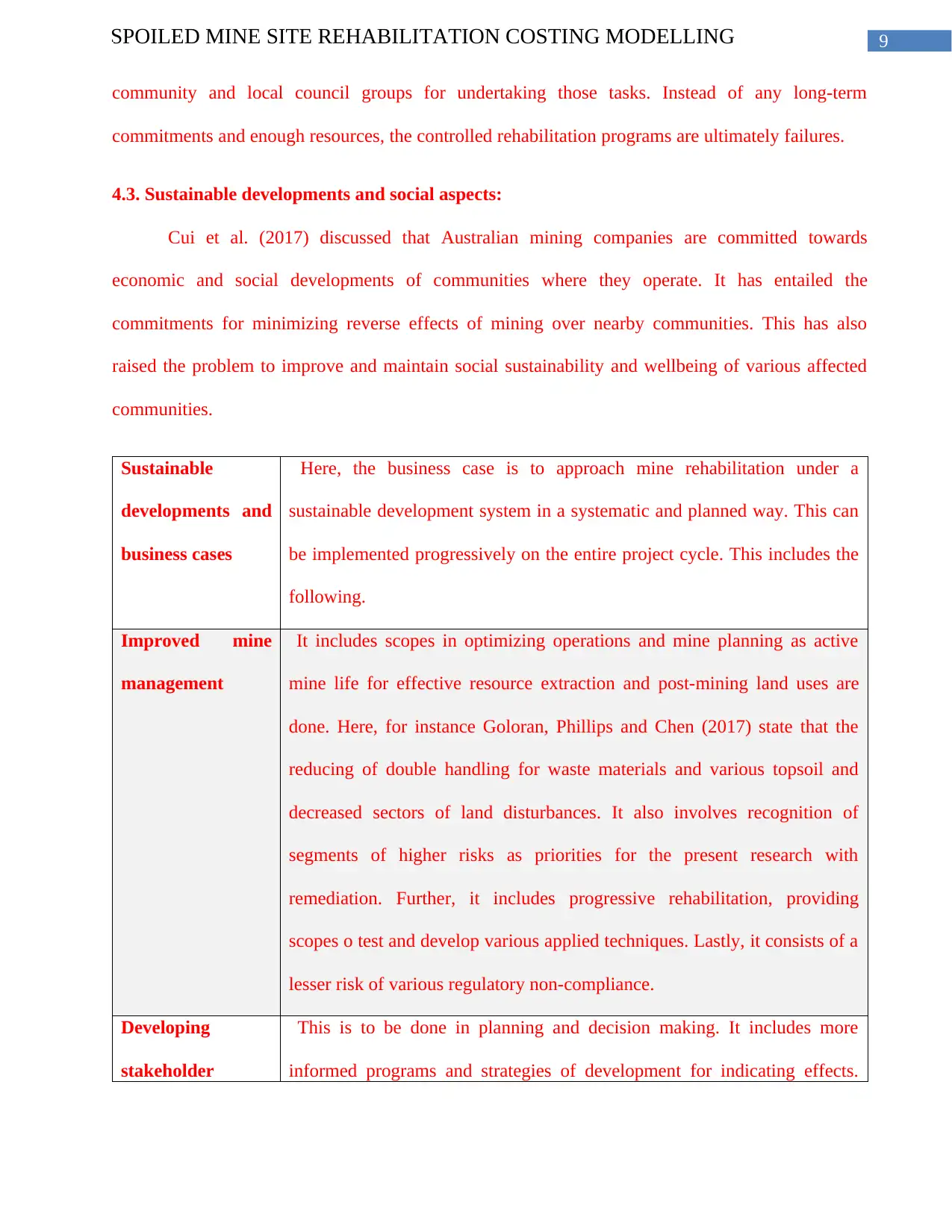
9SPOILED MINE SITE REHABILITATION COSTING MODELLING
community and local council groups for undertaking those tasks. Instead of any long-term
commitments and enough resources, the controlled rehabilitation programs are ultimately failures.
4.3. Sustainable developments and social aspects:
Cui et al. (2017) discussed that Australian mining companies are committed towards
economic and social developments of communities where they operate. It has entailed the
commitments for minimizing reverse effects of mining over nearby communities. This has also
raised the problem to improve and maintain social sustainability and wellbeing of various affected
communities.
Sustainable
developments and
business cases
Here, the business case is to approach mine rehabilitation under a
sustainable development system in a systematic and planned way. This can
be implemented progressively on the entire project cycle. This includes the
following.
Improved mine
management
It includes scopes in optimizing operations and mine planning as active
mine life for effective resource extraction and post-mining land uses are
done. Here, for instance Goloran, Phillips and Chen (2017) state that the
reducing of double handling for waste materials and various topsoil and
decreased sectors of land disturbances. It also involves recognition of
segments of higher risks as priorities for the present research with
remediation. Further, it includes progressive rehabilitation, providing
scopes o test and develop various applied techniques. Lastly, it consists of a
lesser risk of various regulatory non-compliance.
Developing
stakeholder
This is to be done in planning and decision making. It includes more
informed programs and strategies of development for indicating effects.
community and local council groups for undertaking those tasks. Instead of any long-term
commitments and enough resources, the controlled rehabilitation programs are ultimately failures.
4.3. Sustainable developments and social aspects:
Cui et al. (2017) discussed that Australian mining companies are committed towards
economic and social developments of communities where they operate. It has entailed the
commitments for minimizing reverse effects of mining over nearby communities. This has also
raised the problem to improve and maintain social sustainability and wellbeing of various affected
communities.
Sustainable
developments and
business cases
Here, the business case is to approach mine rehabilitation under a
sustainable development system in a systematic and planned way. This can
be implemented progressively on the entire project cycle. This includes the
following.
Improved mine
management
It includes scopes in optimizing operations and mine planning as active
mine life for effective resource extraction and post-mining land uses are
done. Here, for instance Goloran, Phillips and Chen (2017) state that the
reducing of double handling for waste materials and various topsoil and
decreased sectors of land disturbances. It also involves recognition of
segments of higher risks as priorities for the present research with
remediation. Further, it includes progressive rehabilitation, providing
scopes o test and develop various applied techniques. Lastly, it consists of a
lesser risk of various regulatory non-compliance.
Developing
stakeholder
This is to be done in planning and decision making. It includes more
informed programs and strategies of development for indicating effects.
Paraphrase This Document
Need a fresh take? Get an instant paraphrase of this document with our AI Paraphraser
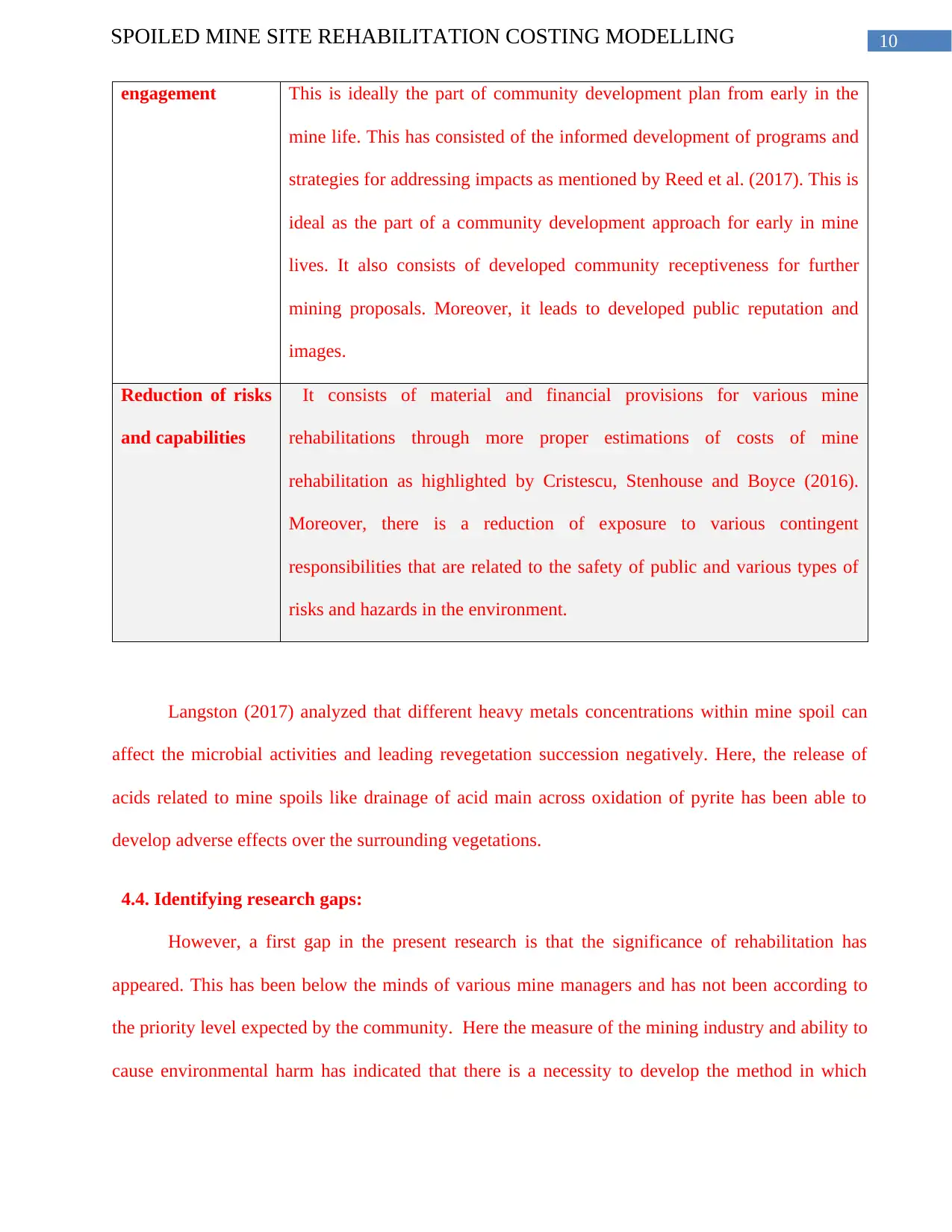
10SPOILED MINE SITE REHABILITATION COSTING MODELLING
engagement This is ideally the part of community development plan from early in the
mine life. This has consisted of the informed development of programs and
strategies for addressing impacts as mentioned by Reed et al. (2017). This is
ideal as the part of a community development approach for early in mine
lives. It also consists of developed community receptiveness for further
mining proposals. Moreover, it leads to developed public reputation and
images.
Reduction of risks
and capabilities
It consists of material and financial provisions for various mine
rehabilitations through more proper estimations of costs of mine
rehabilitation as highlighted by Cristescu, Stenhouse and Boyce (2016).
Moreover, there is a reduction of exposure to various contingent
responsibilities that are related to the safety of public and various types of
risks and hazards in the environment.
Langston (2017) analyzed that different heavy metals concentrations within mine spoil can
affect the microbial activities and leading revegetation succession negatively. Here, the release of
acids related to mine spoils like drainage of acid main across oxidation of pyrite has been able to
develop adverse effects over the surrounding vegetations.
4.4. Identifying research gaps:
However, a first gap in the present research is that the significance of rehabilitation has
appeared. This has been below the minds of various mine managers and has not been according to
the priority level expected by the community. Here the measure of the mining industry and ability to
cause environmental harm has indicated that there is a necessity to develop the method in which
engagement This is ideally the part of community development plan from early in the
mine life. This has consisted of the informed development of programs and
strategies for addressing impacts as mentioned by Reed et al. (2017). This is
ideal as the part of a community development approach for early in mine
lives. It also consists of developed community receptiveness for further
mining proposals. Moreover, it leads to developed public reputation and
images.
Reduction of risks
and capabilities
It consists of material and financial provisions for various mine
rehabilitations through more proper estimations of costs of mine
rehabilitation as highlighted by Cristescu, Stenhouse and Boyce (2016).
Moreover, there is a reduction of exposure to various contingent
responsibilities that are related to the safety of public and various types of
risks and hazards in the environment.
Langston (2017) analyzed that different heavy metals concentrations within mine spoil can
affect the microbial activities and leading revegetation succession negatively. Here, the release of
acids related to mine spoils like drainage of acid main across oxidation of pyrite has been able to
develop adverse effects over the surrounding vegetations.
4.4. Identifying research gaps:
However, a first gap in the present research is that the significance of rehabilitation has
appeared. This has been below the minds of various mine managers and has not been according to
the priority level expected by the community. Here the measure of the mining industry and ability to
cause environmental harm has indicated that there is a necessity to develop the method in which
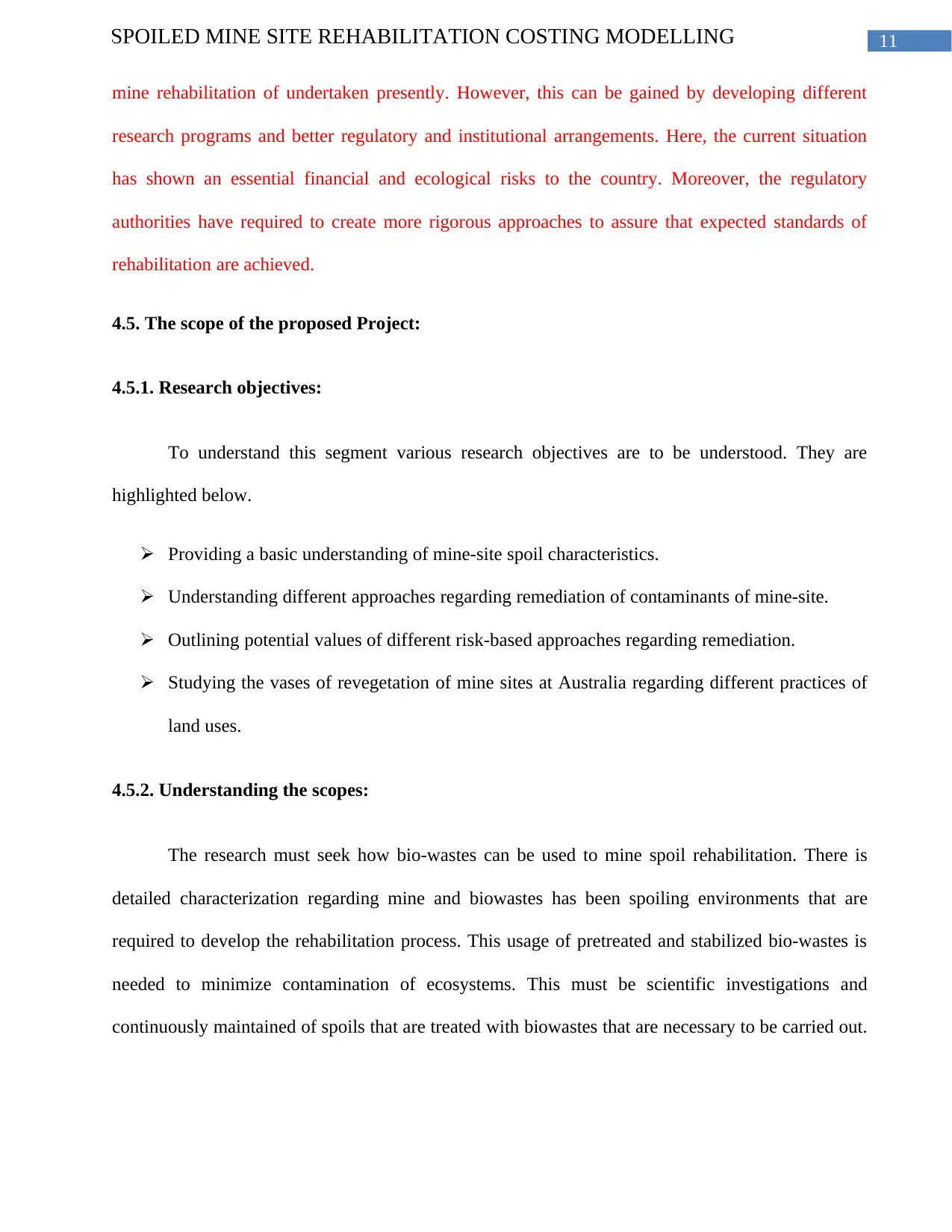
11SPOILED MINE SITE REHABILITATION COSTING MODELLING
mine rehabilitation of undertaken presently. However, this can be gained by developing different
research programs and better regulatory and institutional arrangements. Here, the current situation
has shown an essential financial and ecological risks to the country. Moreover, the regulatory
authorities have required to create more rigorous approaches to assure that expected standards of
rehabilitation are achieved.
4.5. The scope of the proposed Project:
4.5.1. Research objectives:
To understand this segment various research objectives are to be understood. They are
highlighted below.
Providing a basic understanding of mine-site spoil characteristics.
Understanding different approaches regarding remediation of contaminants of mine-site.
Outlining potential values of different risk-based approaches regarding remediation.
Studying the vases of revegetation of mine sites at Australia regarding different practices of
land uses.
4.5.2. Understanding the scopes:
The research must seek how bio-wastes can be used to mine spoil rehabilitation. There is
detailed characterization regarding mine and biowastes has been spoiling environments that are
required to develop the rehabilitation process. This usage of pretreated and stabilized bio-wastes is
needed to minimize contamination of ecosystems. This must be scientific investigations and
continuously maintained of spoils that are treated with biowastes that are necessary to be carried out.
mine rehabilitation of undertaken presently. However, this can be gained by developing different
research programs and better regulatory and institutional arrangements. Here, the current situation
has shown an essential financial and ecological risks to the country. Moreover, the regulatory
authorities have required to create more rigorous approaches to assure that expected standards of
rehabilitation are achieved.
4.5. The scope of the proposed Project:
4.5.1. Research objectives:
To understand this segment various research objectives are to be understood. They are
highlighted below.
Providing a basic understanding of mine-site spoil characteristics.
Understanding different approaches regarding remediation of contaminants of mine-site.
Outlining potential values of different risk-based approaches regarding remediation.
Studying the vases of revegetation of mine sites at Australia regarding different practices of
land uses.
4.5.2. Understanding the scopes:
The research must seek how bio-wastes can be used to mine spoil rehabilitation. There is
detailed characterization regarding mine and biowastes has been spoiling environments that are
required to develop the rehabilitation process. This usage of pretreated and stabilized bio-wastes is
needed to minimize contamination of ecosystems. This must be scientific investigations and
continuously maintained of spoils that are treated with biowastes that are necessary to be carried out.
⊘ This is a preview!⊘
Do you want full access?
Subscribe today to unlock all pages.

Trusted by 1+ million students worldwide
1 out of 23
Related Documents
Your All-in-One AI-Powered Toolkit for Academic Success.
+13062052269
info@desklib.com
Available 24*7 on WhatsApp / Email
![[object Object]](/_next/static/media/star-bottom.7253800d.svg)
Unlock your academic potential
Copyright © 2020–2025 A2Z Services. All Rights Reserved. Developed and managed by ZUCOL.





